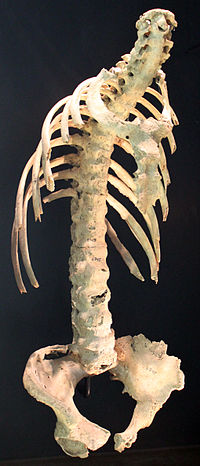
Photo from wikipedia
Objective The objective was to compare thoracic spinal stiffness between healthy participants and participants with chronic thoracic pain and to explore the associations between spinal stiffness, pain and muscle activity.… Click to show full abstract
Objective The objective was to compare thoracic spinal stiffness between healthy participants and participants with chronic thoracic pain and to explore the associations between spinal stiffness, pain and muscle activity. The reliability of spinal stiffness was also evaluated. Material and methods Spinal stiffness was assessed from T5 to T8 using a mechanical device in 25 healthy participants and 50 participants with chronic thoracic pain (symptoms had to be reported within the evaluated region of the back). The spinal levels for which spinal stiffness was measured were standardized (i.e. T5 to T8 for all participants) to minimize between-individual variations due to the evaluation of different spinal levels. The device load and displacement data were used to calculate the global and terminal spinal stiffness coefficients at each spinal level. Immediately after each assessment, participants were asked to rate their pain intensity during the trial, while thoracic muscle activity was recorded during the load application using surface electromyography electrodes (sEMG). Within- and between-day reliability were evaluated using intraclass correlation coefficients (ICC), while the effects of chronic thoracic pain and spinal levels on spinal stiffness and sEMG activity were assessed using mixed model ANOVAs. Correlations between pain intensity, muscle activity and spinal stiffness were also computed. Results ICC values for within- and between-day reliability of spinal stiffness ranged from 0.67 to 0.91 and from 0.60 to 0.94 (except at T5), respectively. A significant decrease in the global (F1,73 = 4.04, p = 0.048) and terminal (F1,73 = 4.93, p = 0.03) spinal stiffness was observed in participants with thoracic pain. sEMG activity was not significantly different between groups and between spinal levels. Pain intensity was only significantly and "moderately" correlated to spinal stiffness coefficients at one spinal level (-0.29≤r≤-0.51), while sEMG activity and spinal stiffness were not significantly correlated. Conclusion The results suggest that spinal stiffness can be reliably assessed using a mechanical device and that this parameter is decreased in participants with chronic thoracic pain. Studies are required to determine the value of instrumented spinal stiffness assessment in the evaluation and management of patients with chronic spine-related pain.
Journal Title: PLoS ONE
Year Published: 2018
Link to full text (if available)
Share on Social Media: Sign Up to like & get
recommendations!